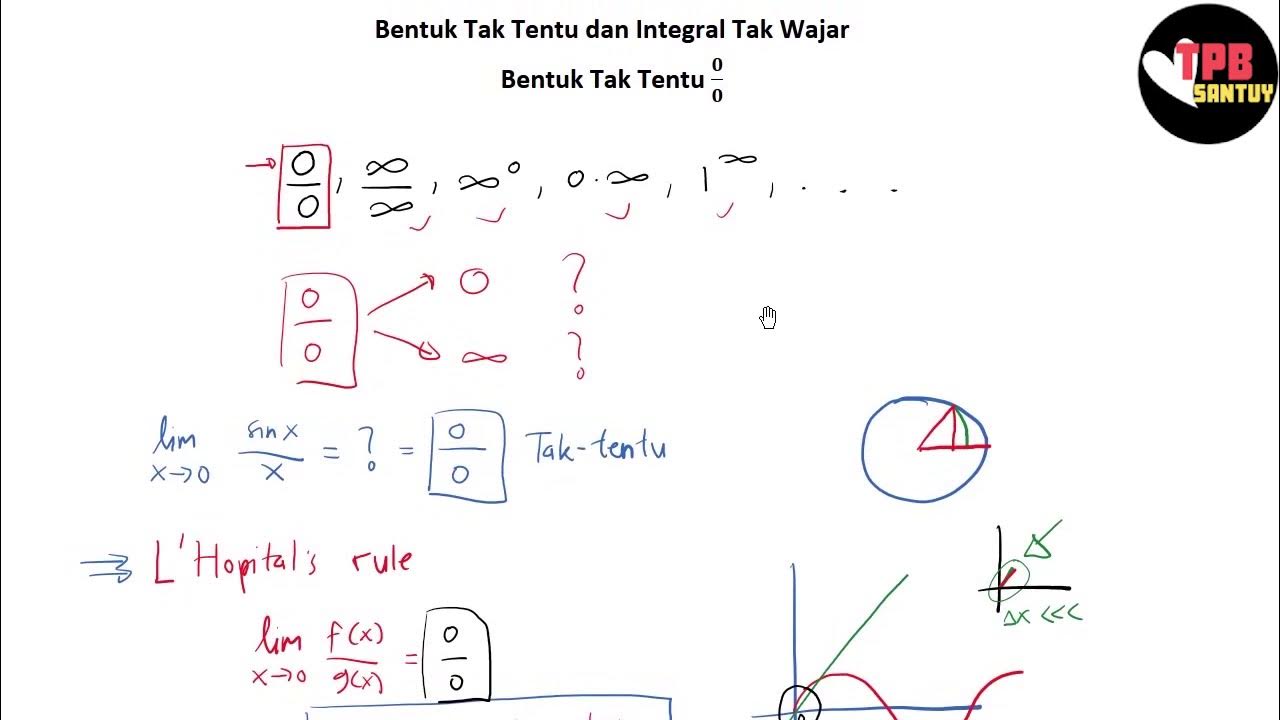KALKULUS INTEGRAL - INTEGRAL TAK WAJAR
Summary
TLDRIn this video, the host explains the concept of improper integrals in calculus, focusing on integrals with infinite limits or discontinuities. The tutorial covers how to compute such integrals using limits, explaining convergence and divergence. Examples are provided, including functions with discontinuities and infinite boundaries. Viewers are guided through the process of splitting integrals at discontinuities and evaluating limits. The video concludes with exercises for practice and an invitation to ask questions. The content is designed to help viewers understand how to work with improper integrals and their applications.
Takeaways
- 😀 Improper integrals involve limits and integrals with infinite bounds or discontinuous functions.
- 😀 The concept of a definite integral is used to calculate the area under a curve, bounded by specific values.
- 😀 For infinite limits, we approach infinity by using a limit as the upper or lower bound of an integral.
- 😀 If an integral has a finite value for the limit, it is said to be convergent; if not, it is divergent.
- 😀 An improper integral with infinite bounds can be calculated using a limit approach.
- 😀 Improper integrals are often applied in probability theory and other areas where infinite limits are encountered.
- 😀 A function is considered discontinuous at a point if its value cannot be determined at that point, or if the left-hand and right-hand limits are not equal.
- 😀 In cases of discontinuity at a boundary, we break the integral into two parts and compute the limits separately.
- 😀 The integral of functions with infinite limits or discontinuities can be checked for convergence by evaluating the limits of each part of the integral.
- 😀 The script explains various examples, including calculating improper integrals with discontinuities and infinite limits, demonstrating the practical applications of the theory.
Q & A
What is the main topic of the video?
-The main topic of the video is the study of improper integrals, specifically those with infinite limits or discontinuous functions.
What is an improper integral?
-An improper integral refers to an integral where one or both of the limits of integration are infinite, or the function being integrated has a discontinuity or an asymptote at some point within the integration range.
How is an improper integral with an infinite upper limit handled?
-An improper integral with an infinite upper limit is handled by converting the integral into a limit as the upper bound approaches infinity. The integral is expressed as a limit of a definite integral with a finite upper bound, which is then evaluated.
How do you calculate an improper integral with a discontinuous function?
-To calculate an improper integral with a discontinuous function, you break the integral at the point of discontinuity and evaluate the limits of the integrals at each side of the discontinuity. If both limits exist and are finite, the integral is considered convergent.
What is the difference between a convergent and divergent integral?
-A convergent integral is one where the value of the integral approaches a finite number as the limit is taken, while a divergent integral is one where the value either does not exist or tends to infinity.
What does it mean for an improper integral to be convergent or divergent in terms of its limit?
-If the limit of the improper integral exists and is finite, the integral is convergent. If the limit does not exist or tends to infinity, the integral is divergent.
Can an improper integral have both infinite limits?
-Yes, an improper integral can have both infinite limits. In such cases, the integral is split into two parts: one for each infinite limit, and each part is evaluated separately using limits.
What is the method used to evaluate improper integrals with discontinuous functions?
-To evaluate improper integrals with discontinuous functions, you use limits to approach the discontinuous point from either the left or right side, depending on where the discontinuity occurs.
How do you determine if an improper integral is convergent or divergent when both limits are infinite?
-When both limits are infinite, you split the integral into two parts, each with one infinite limit. Then, you evaluate the limits of each part separately. If both parts are finite, the overall integral is convergent. If either part is divergent, the entire integral is considered divergent.
What happens if an improper integral involves a function that is not defined at a certain point?
-If the function is not defined at a certain point, the integral is considered improper. You evaluate the integral by taking limits to approach the undefined point from either the left or right, depending on the behavior of the function.
Outlines

Dieser Bereich ist nur für Premium-Benutzer verfügbar. Bitte führen Sie ein Upgrade durch, um auf diesen Abschnitt zuzugreifen.
Upgrade durchführenMindmap

Dieser Bereich ist nur für Premium-Benutzer verfügbar. Bitte führen Sie ein Upgrade durch, um auf diesen Abschnitt zuzugreifen.
Upgrade durchführenKeywords

Dieser Bereich ist nur für Premium-Benutzer verfügbar. Bitte führen Sie ein Upgrade durch, um auf diesen Abschnitt zuzugreifen.
Upgrade durchführenHighlights

Dieser Bereich ist nur für Premium-Benutzer verfügbar. Bitte führen Sie ein Upgrade durch, um auf diesen Abschnitt zuzugreifen.
Upgrade durchführenTranscripts

Dieser Bereich ist nur für Premium-Benutzer verfügbar. Bitte führen Sie ein Upgrade durch, um auf diesen Abschnitt zuzugreifen.
Upgrade durchführenWeitere ähnliche Videos ansehen

Bentuk 0/0 | Bentuk Tak Tentu dan Integral Tak Wajar (Part 1) | Kalkulus

KALKULUS | INTEGRAL | INTEGRAL TAK TENTU (ANTI TURUNAN)

Integrals: Crash Course Physics #3

Eps.2 KALKULUS 2: Teknik Integrasi - Teknik Substitusi

LIMITE: a Ideia Fundamental do Cálculo

¿Qué es la INTEGRAL? | SIGNIFICADO de la integral definida (Lo que no te enseñan sobre la integral)
5.0 / 5 (0 votes)
